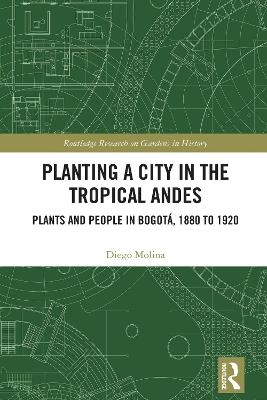
Planting a City in the Tropical Andes
Routledge (Verlag)
978-1-032-07656-0 (ISBN)
Urbanisation is one of the main forces behind biodiversity loss. Paradoxically, the expansion of cities has made urban environment spaces with a greater numbers of plant species compared to their surrounding areas. Planting a City in the Tropical Andes takes a multidisciplinary approach to shed light on the cultural and ecological mechanisms that have transformed modern cities into what can be described as ‘floristic islands’. By drawing upon a wide array of historical sources, this book explains how the 19th-century modernization of Bogotá (Colombia), led to the replacement of traditional botanical practices with technical knowledge, which in turn endowed the city with a unique floristic inventory. Through a unique botanical perspective on Latin American urban history, this book uncovers how capitalist dynamics in Bogotá transformed plants into providers of clean air and water and their use in the urban landscape contributed to the cultivation of disciplined citizenry. Placing plants at the forefront of its narrative, the book offers an original contribution to the underexplored history of horticulture in tropical Latin America. It serves as a compelling example of how the creative and conflicting forces of the Anthropocene have forged new environments and previously unseen relationships between people and plants.
This volume will be of great use to scholars and students interested in social history, urban environmental histories and cultural history.
Diego Molina is a British Academy Postdoctoral Fellow at Royal Holloway, University of London. He is a botanist who turned to historical geography to understand the changing relationships between people and plants. Before becoming a British Academy Fellow at the RHUL, he was a Rachel Carson Fellow in Munich.
1. The Genesis of Bogotá’s Mixed Flora 2. Urban Spaces, Cultivated Plants and People 3. The ‘invisible’ Flora 4. From colonial squares to hygienic gardens 5. The gardeners 6. The plants 7. New and disciplined relationships with Plants 8. A treeless and desolate land 9. The alamedas and the liberty tree 10. Eucalyptus: the all-purpose tree
| Erscheinungsdatum | 12.09.2024 |
|---|---|
| Reihe/Serie | Routledge Research on Gardens in History |
| Zusatzinfo | 5 Tables, black and white; 36 Halftones, black and white; 36 Illustrations, black and white |
| Verlagsort | London |
| Sprache | englisch |
| Maße | 152 x 229 mm |
| Gewicht | 616 g |
| Themenwelt | Geschichte ► Teilgebiete der Geschichte ► Kulturgeschichte |
| Geschichte ► Teilgebiete der Geschichte ► Wirtschaftsgeschichte | |
| Naturwissenschaften ► Biologie ► Botanik | |
| Sozialwissenschaften ► Soziologie | |
| Technik ► Umwelttechnik / Biotechnologie | |
| ISBN-10 | 1-032-07656-9 / 1032076569 |
| ISBN-13 | 978-1-032-07656-0 / 9781032076560 |
| Zustand | Neuware |
| Informationen gemäß Produktsicherheitsverordnung (GPSR) | |
| Haben Sie eine Frage zum Produkt? |
aus dem Bereich


